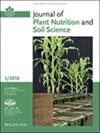Fusion of Vis-Near and Mid-Infrared Spectroscopic Data for a Prediction of Biochar C, Native Soil Organic C and Root C in a Designed Experiment With Loess Soils
Abstract
Background
The accuracy of predictions using visible to near-infrared (vis–NIR) and mid-infrared (MIR) spectroscopy for different organic compounds in arable soils is not sufficiently quantified and designed experiments are useful to assess the potential.
Aim
Objectives were to quantify the predictive accuracy of regressions using MIR and vis–NIR spectra for total organic carbon (OC), native soil OC (native SOC), aged biochar and root C in loess soils.
Methods
Maize roots and biochar were added at mean rates (± standard deviation) of 2 (±0.5) and 15 (±3.75) g C kg−1 to soils from three different loess sites to obtain 450 soils and their spectra were recorded. Partial least squares regression (PLSR) and support vector machine regressions (SVMR) were used in three-fold partitioning with (1) pseudo-independent calibration and validation and (2) calibration and validation for the respective sites with and without spiking.
Results
Data fusion (concatenation or outer product analysis) using SVMR were the most successful approaches in the validations for all training strategies (0.81 ≤ mean R2 ≤ 0.98) for total OC, added biochar C, combined native SOC + added root C, and native SOC, but failed to accurately predict added root C separately from total OC. Variable importance in the projection of PLSR indicated a good differentiation between biochar C and other organic compounds, but not between native SOC + added root C and native SOC.
Conclusions
For rates of root and biochar C inputs which are typical in agricultural experiments, fusion and spiking allowed a quantitative differentiation of total OC into biochar C and native SOC + root C, but not a separate quantification of root C.


 求助内容:
求助内容: 应助结果提醒方式:
应助结果提醒方式:


